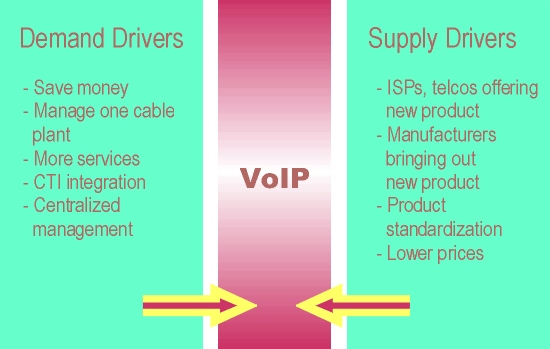Voice over IP Online Course
Lesson 2 - Why VoIP?
D. Driving VoIP
Driving VoIP
- Users, individuals or organizations
- ISPs
- Manufacturers
The VoIP technology will not be adopted unless there is a measurable benefit to stakeholders.
Users
Users, either as individuals or organizations, need to see some benefits of VoIP. The benefits were discussed in the earlier section and include savings in telephone charges, savings in administration and maintenance costs and greater capabilities. What end users want is relatively well understood: high-quality voice, “always-on” dial tone, easy-to-use features, and new applications.Service Providers
Service providers fall into two categories, those who only provide data services including access to the Internet (Internet Service Providers- ISPs) and those who provide analog voice service as well as data (telcos). The first group has a clear desire for the success of VoIP since it will increase the volume of data, hence revenue, plus steal business from the traditional telephone companies.The second group is ambivalent about VoIP. On the one hand, as providers of data services, they will benefit from the increase in data traffic. On the other hand, as suppliers of the analog service, their traditional revenue will decrease as VoIP becomes more popular.
The traditional telcos know that VoIP will become the standard technology for the telephone system; it is just a question of when. They have all worked VoIP into their business plans; now it just a question of scheduling the implementationManufacturers
Manufacturers are looking for an opportunity to generate revenue. Whenever a new technology field opens up, there is an opportunity for startup companies to provide cutting edge products. This is the case with VoIP where startups were the first out with innovative products. Now that customers have shown an interest, established companies have followed with their own products. Companies that exist in the IP space, particularly Cisco, see VoIP as a brand new marketing opportunity. The companies that have traditionally supplied the telcos with their voice gear have a need to protect their installed base. Nortel, Lucent and Alcatel are as interested in upgrading PBXs and central office equipment to VoIP as they are in end-to-end VoIP. In some ways this last group is ambivalent about VoIP since their sales of traditional voice gear has plummeted while their sales of VoIP equipment has not increased enough to fill the vacuum.
Figure 8: Drivers for VoIP technology
[Top of page][On to next section]
